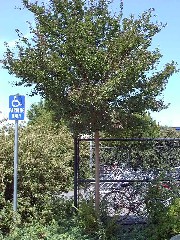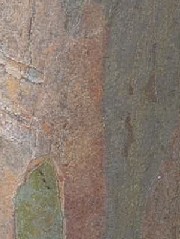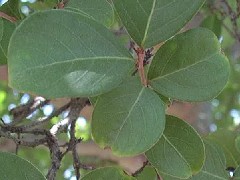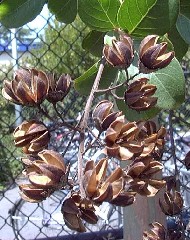Crape Myrtle
Lagerstroemia sp.Podcast Script
 Crape Myrtle, full picture |
 Bark of the Crape Myrtle |
 Leaf of the Crape Myrtle |
 Fruit of the Crape Myrtle |
Classification:
Angiosperm, Dicot, deciduousSize:
Common species for gardening grow from 18 inches to 30 feet tall, spreading up to 25 feet.Identifying Features:
The Crape Myrtle is mostly known for its clusters of small brightly colored flowers that resemble crepe paper that bloom during the summer. In fall, the foliage turns orange, red, and yellow. The trunk and stems are covered in a smooth, peeling bark, that is brown with a pinkish tinge. When the bark peels, the new bark appears green. The leaves for the most part are alternate, but in the upper stems the leaves may become opposite.Location/Habitat:
Crape Myrtles originated in Asia. Due to its hardiness, the Crape Myrtle is now grown within the U.S. from California to Florida, and many other countries across the world. The Crape Myrtle will grow well within cold zones 6 through 10, and within most soil. To promote growth, the Crape Myrtle should be placed in full sun.Flower/Fruit/Reproduction:
Crape myrtles produce clusters of small symmetrical flowers. The flowers, about 1-2 inches in diameter, have crinkled petals that give the Crape myrtle its name (the Crape myrtle is also called "Crepe Myrtle"). After flowering, Crape Myrtles produce small brown fruit capsules with six compartments arranged into upright spikes. Crape Myrtle can reproduce through cuttings taken in early fall, or through the seeds contained within the fruit. The Crape Myrtle is capable of reproducing with itself.Water/Sun Requirements:
Full sun and temperatures above 70 degrees Fahrenheit promote flowering. The Crape Myrtle can withstand drought like conditions, but should be watered at least once a week until it establishes itself within the soil.Special Adaptations:
.The Crape Myrtle can withstand dry conditions, and is resistant to powdery mildew diseases.Other Info:
Some species of Lagerstroemia are used for timber. The wood gathered from the Crape Myrtle resembles the timber of teak. In Southeast Asia, the leaves of Lagerstroemia speciosa are dried, crushed, and brewed into a tea that helps treat diabetes.Reference Sources/Links:
Texas Agriculture Experiment Station Site, Crape Myrtle:http://dallas.tamu.edu/woody/cmyrtle/intro.html
http://dallas.tamu.edu/woody/cmyrtle/uses.html
Southern Group of State Forresters, US dept. of Agriculture:
http://hort.ufl.edu/trees/LAGINDA.pdf
Floridata:
http://www.floridata.com/ref/l/lager_i.cfm
Created by Robert M. 2007